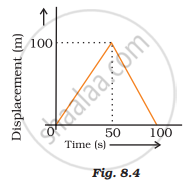Advertisements
Advertisements
प्रश्न
A freely falling object travels 4.9 m in 1st second, 14.7 m in 2 nd second, 24.5 m in 3rd second, and so on. This data shows that the motion of a freely falling object is a case of :
पर्याय
uniform motion
uniform acceleration
no acceleration
uniform velocity
उत्तर
uniform acceleration
The displacement of the body in equal interval of time is unequal, but acceleration is constant. The acceleration will thus be uniform, so the answer is (b).
APPEARS IN
संबंधित प्रश्न
A train starting from stationary position and moving with uniform acceleration attains a speed of 36 km per hour in 10 minutes. Find its acceleration.
Give one example of following motion :
Variable acceleration
The figure shows the displacement - time graph for four bodies A, B C and D. In each case state what information do you get about the acceleration (zero, positive or negative).

The velocity-time graph of a body in motion is a straight line inclined to the time axis. The correct statement is ___________
For a uniformly retarded motion, the velocity-time graph is _____________
How can you find the following?
Acceleration from velocity – time graph.
How can you find the following?
Velocity from acceleration – time graph.
A stone thrown vertically upwards takes 3 s to attain maximum height. Calculate
- initial velocity of the stone
- maximum height attained by the stone. (Take g = 9.8 ms−2)
A girl walks along a straight path to drop a letter in the letterbox and comes back to her initial position. Her displacement–time graph is shown in Fig.8.4. Plot a velocity-time graph for the same.

When will you say a body is at uniform acceleration?
